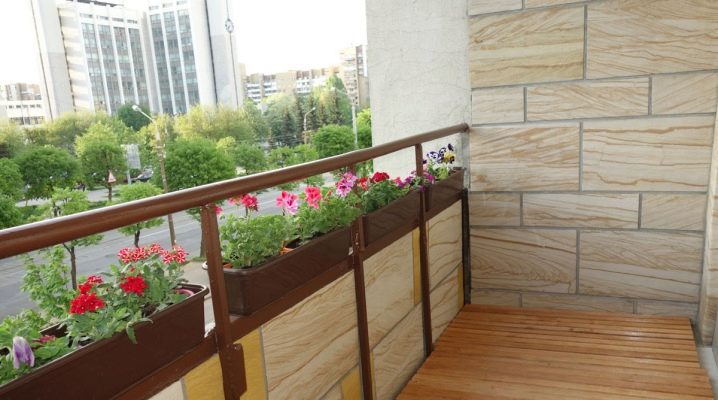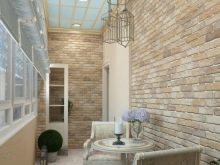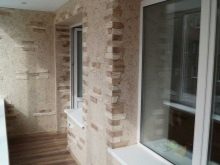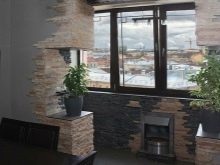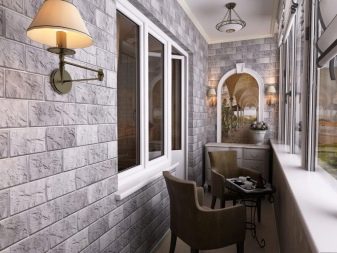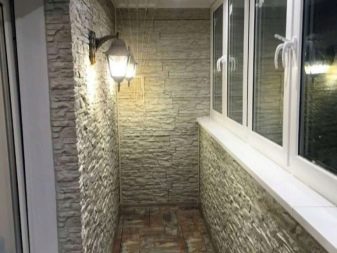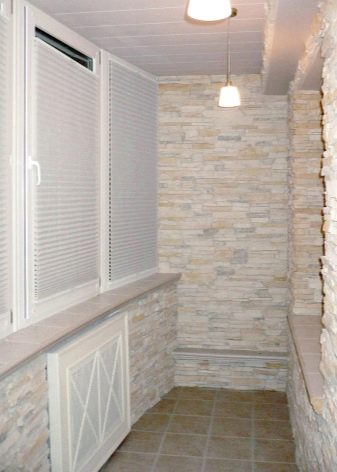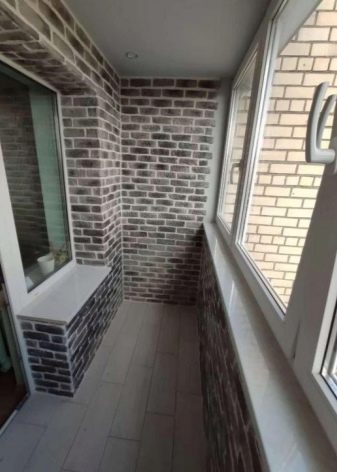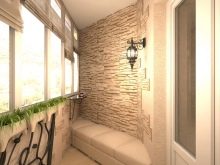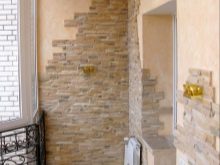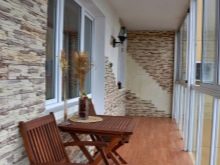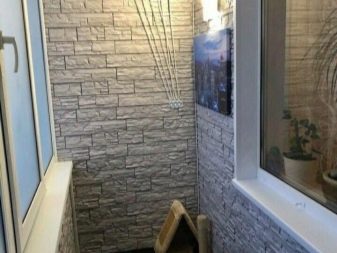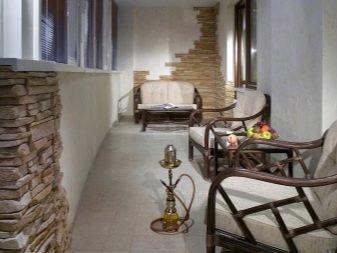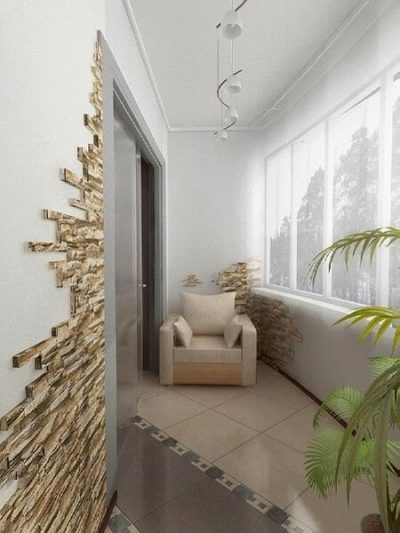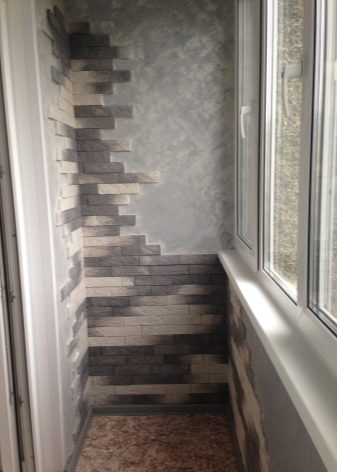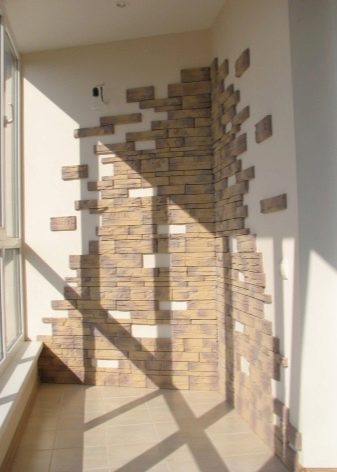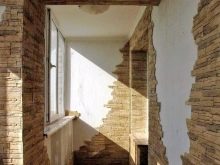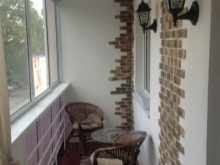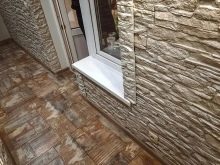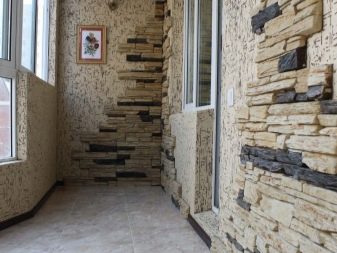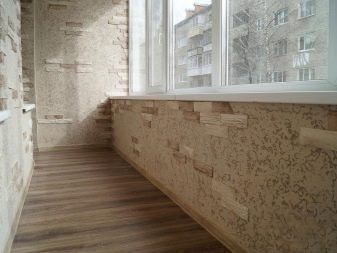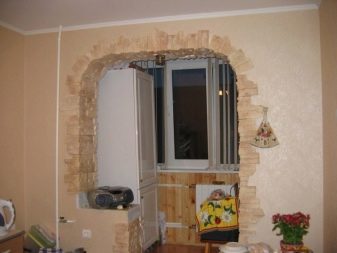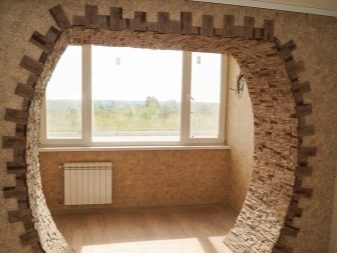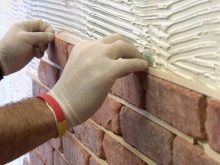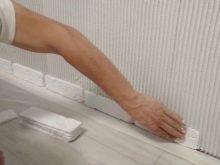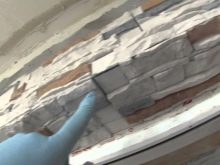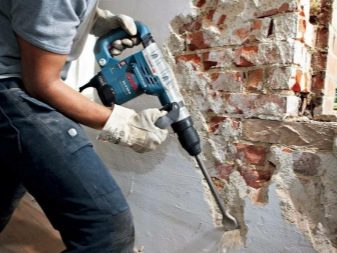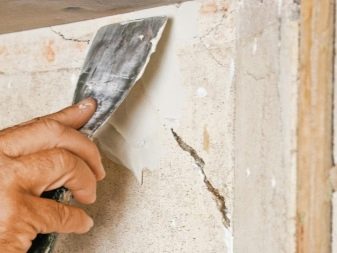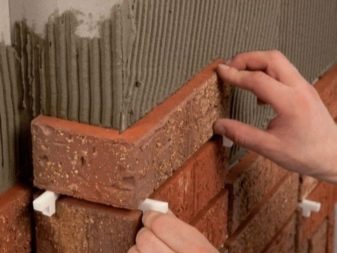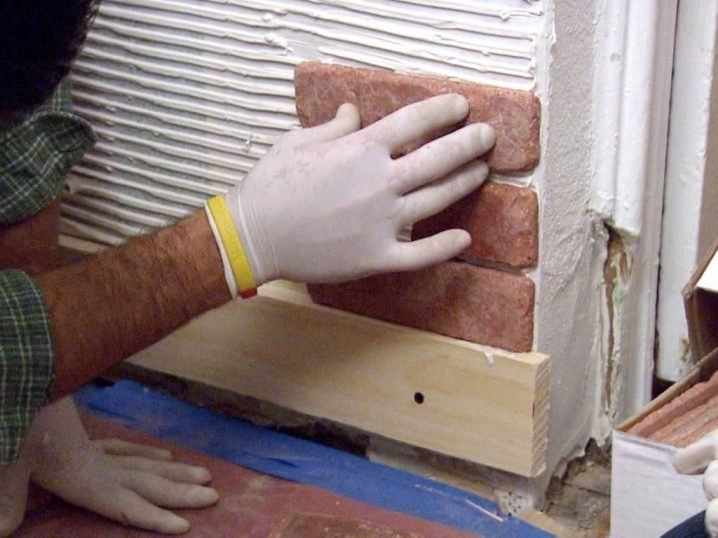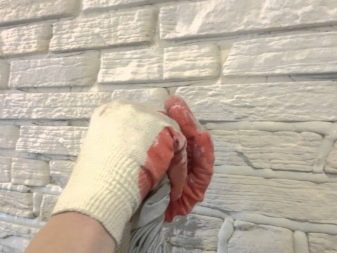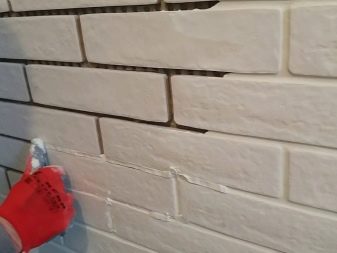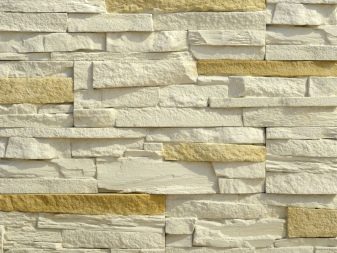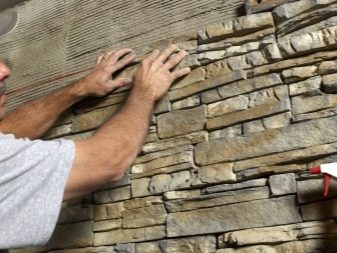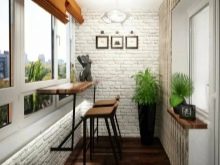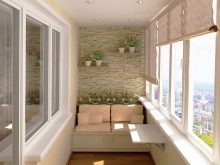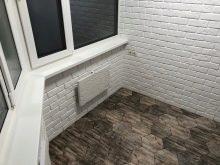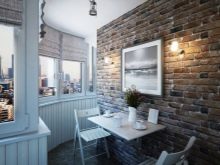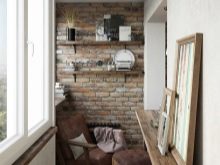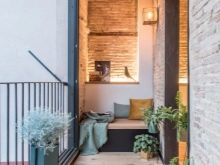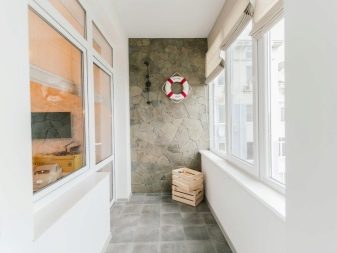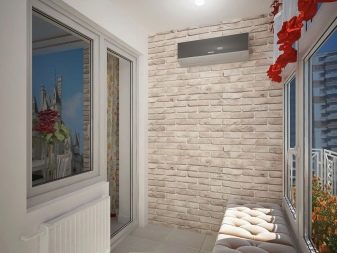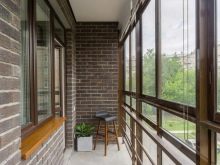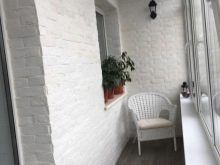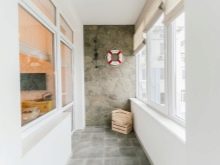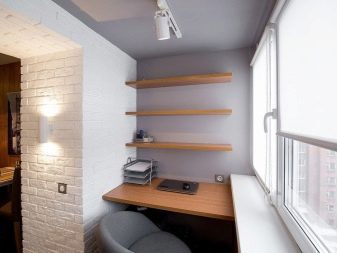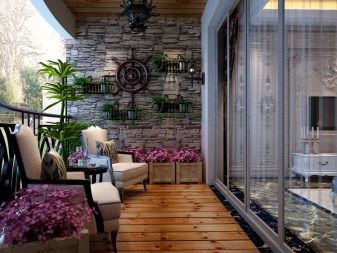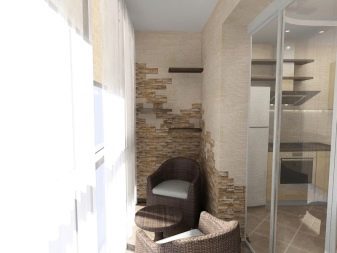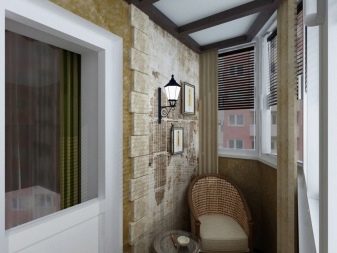Decorating the balcony and loggia with decorative stone
It is becoming more and more popular to decorate the balcony with decorative stone, which implies facing the inner surface with artificial tiles. With the increase in the footage of balconies and loggias in new buildings and the emergence of modern thermal insulation materials, such an interior design has shown its effectiveness and practicality.
Advantages and disadvantages
Masonry is most often used in the interior of balconies and loggias. Among the facing materials, natural and artificial stone are distinguished. Each of the listed varieties has its own advantages and disadvantages, therefore, before making a design, you should carefully consider the properties and appearance of the options presented on the construction market.
The disadvantages of natural building materials include high weight and high cost. However, such a stone is distinguished by good performance characteristics, strength and durability, which favorably distinguishes it when compared with other finishing materials.
Decorative stone is produced mainly in the form of tiles; in addition to concrete, it contains sand and cement, as well as additional additives. Plasticizers in the composition are necessary to comply with the manufacturing technology. Coloring pigments help to give the stone the desired color. Water-repellent additives improve the hydrophobicity of the facing stone.
In addition, a variety of fillers made of ceramic chips and expanded clay enhance the performance properties of artificial building materials.
This type of stone has a relatively low weight, therefore, the use of particularly strong adhesives and the strengthening of the balcony slab are not required. In addition, decorative cladding is quite easy to handle and install. You can cope on your own when carrying out work without the involvement of professional builders. Among the many available cladding options, it is possible to find a huge variety of colors, textures and patterns. It is quite easy to care for such a surface, it is environmentally friendly, hypoallergenic and high-tech.
Thus, after comparing the two types of stones, it turned out that the use of decorative stone for facing inside the balcony and loggia is much cheaper, easier to install and more attractive in design, but at the same time it loses a little to natural masonry in operational properties. Natural stone is more resistant to sudden changes in temperature and humidity, as well as mechanical stress.
Material selection
Some owners prefer to carry out repair or finishing work with their own hands. A decorative stone is perfect for this. Moreover, cladding with artificial stone will be an excellent option when decorating a glazed balcony or loggia. This coating will give the interior a respectable look and will create a cozy corner for relaxation or reading.
Decorative stone is made from concrete with the addition of various binders. A wide variety of produced forms of decorative stones allows apartment owners to determine the most suitable option for any design solution. When choosing cladding materials, primary importance is attached to the color scale and type of building material. In addition, it is important to take into account the texture of the material.Decorative items stylized as natural stone, brickwork and limestone bricks look advantageous in the apartment. Gypsum material is less durable, and often does not withstand high humidity in the room.
Therefore, the best option would be to purchase a decorative stone with a water-repellent coating and additional treatment against the formation of mold fungi.
Where to locate?
Due to the ease of installation, decorative elements can be assembled in various ways, placing them on different parts of the surfaces. Decorative stone can be placed on walls, slopes and corners. On open balconies, the wall adjoining the house is decorated with tiles. On a glazed balcony with insulation, finishing is done either along the entire balcony perimeter, or by partial laying on separate coatings.
When decorating the balcony space, you can use fragments of artificial products, for example, decorate the corners in an asymmetric way. Horizontal rows of paved tiles will help to visually enlarge a narrow balcony. The corners decorated with decorative elements look harmonious. Another option is to tile the slopes. This solution can be combined with a full wall cladding opposite the window.
If there is an arch on the balcony, it, like the walls, can be tiled. This design decision will create a successful transition between adjacent areas. With partial finishing of the balcony wall, you can randomly distribute bricks over the surface, which will add comfort and ease to the interior.
Installation instructions
Before starting repair work, you must pay close attention to studying the installation instructions for the cladding material. In the process of work, it is extremely important to comply with the prescribed safety measures and the manufacturer's recommendations.
Before laying the stone, you need to mark the layout of the cladding. It is recommended to pre-spread the stones on the floor surface. This will help you look at the composition, which will facilitate the editing process. Products can be numbered if necessary.
In order to properly sheathe the work surface, first you should carefully examine the wall, carry out a cleaning and prepare it for sheathing. If cracks, irregularities and potholes are found on the walls, they need to be plastered. Wooden and plasterboard walls should be treated by attaching a galvanized mesh and applying a layer of plaster.
Do not leave old coating and poorly fixed plaster on the surface. On a porous or dusty surface, you need to apply an additional coating from a primer, and you should also treat the back surface of the stone with it, which will facilitate installation work.
Then the preparation of the glue or cement mortar is carried out. In the process of stirring it, you need to follow the instructions of the instructions that were on the package, maintaining the desired proportions. The resulting styling mixture should be plastic and rather thick.
A solution about 5 mm thick is applied to the prepared wall surface, after which the coating is leveled with a notched trowel. The same layer is applied to the back surface of the stone, and then the stone is forcefully pressed into the solution by pressing firmly against the wall and held for a few seconds for secure fixation. The following tiles are laid in the same way.
It is preferable to start the cladding at the corners and move further in the horizontal direction. You should alternate whole and half tiles with each other. It is better to lay out the products from top to bottom, since it is customary to trim from the floor.
With jointing
With this method of laying, stones are placed at a small distance between adjacent slabs, observing the same width of the joints. After completing the laying of the stone, the resulting seams are filled with a special solution, and then sealed with jointing.
Without joining
Such a laying of decorative stone elements assumes the most dense arrangement of stones, due to which a monolithic surface is formed. It is important to remove the resulting excess adhesive solution in a timely manner using a spatula.
Beautiful examples
To transform the balcony, apartment owners use various finishing methods, depending on their own taste preferences. A responsible approach to the selection of building materials plays a key role in the quality and durability of decorative structures.
The design of the balcony depends on its size. For small premises, small stones with narrow masonry are better suited, for spacious balconies and wide loggias - any size and texture of stone. Light colors allow you to visually expand a narrow space. Masonry can cover only one of the walls or a separate part of it, which will create an original design.
Most apartment owners prefer a style called loft, which means interior decoration with brickwork. In some cases, the tiles are replaced with flexible stone, which is made by cutting the thinnest layer of sandstone and then applying the canvas to the fiberglass. Such a stone easily takes the desired shape, so it is used for cladding surfaces that are not subject to deformation.
For the arrangement of the balcony space, liquid wallpaper is also used due to the ease of application and thermal insulation of the material. Liquid wallpaper is fairly easy to restore, level the walls and repel dust.
The minimalism style is also very popular. Balcony owners choose design with natural accents. When decorating space, indoor plants are increasingly used.
It is not uncommon to create a design that uses a combination of decorative tiles with other materials for decoration. An equally stylish solution is painting the walls of the balcony, creating a bright contrast or matching the stone decor.
